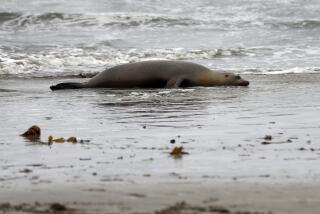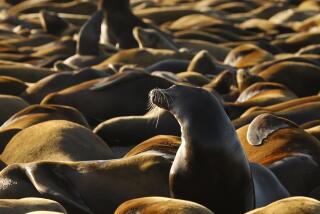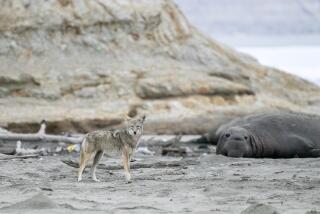Baby monk seals are at heart of new hospital in Hawaii
- Share via
A new hospital has opened in Hawaii with the sole purpose of saving one of the world’s most endangered animals from extinction.
Before its official opening Tuesday, the Marine Mammal Center’s Ke Kai Ola (“The Healing Sea”) had already treated four ailing Hawaiian monk seals – the only tropical seal in existence -- and released them. They were returned by a NOAA vessel to their home among the islets, atolls and coral reefs of the Northwestern Hawaiian Islands, where scientists will seek out other sick seals for treatment.
Senior scientist Frances Gulland was chasing reports of “thin pups” earlier this week. And it’s the babies that are the focus of this campaign, based out of the new $3.2 million facility in Kona, on the Big Island. The hope is that by saving young monk seals, an entire species will be preserved.
“Four out of five pups are dying,” Gulland told the L.A. Times in an interview Tuesday. “The emphasis is to bring more female pups up to become breeding females.”
There are only about 1,000 Hawaiian monk seals; by comparison, there are 150,000 northern elephant seals worldwide and half a million harbor seals. The monk seal lives and breeds primarily among the isolated Northwestern islands, which extend 1,200 miles northwest of Hawaii’s main islands.
In 2006, the Northwestern region became a national monument, part of a 140,000-square-mile protected marine wonderland that provides a home and breeding grounds for 7,000 species. (Take a quick spin through some of those islands.)
Monk seals, which tend to be solitary, rest on the beaches and volcanic rock of these isolated islands. They swim its blue-green waters and forage its sea beds for food, “going along and turning rocks over” to consume the rockfish that emerge, Gulland said.
The adult seals are silvery gray and grow to 7 or 7 1/2 feet long and 375 to 450 pounds. The babies are about 35 pounds and 3 feet long at birth. They’re much darker than the parent, Gulland said, and have a white patch on their bellies.
Females have only one pup a year, the scientist said. They look for protected, sandy beaches to have their pups, then guard their young, while fasting, for five to six weeks.
The mothers are steadfast and few pups are abandoned, Gulland said. The trouble comes later.
As monk seals teeter on the edge of extinction, survival of juveniles is particularly low and declining. Gulland said just one in five makes it to adulthood, and they’re felled by causes that often can be traced to humans.
The food chain, she said, is distorted in the area from overfishing. Lobster, once a primary source of food for the monk seals, has been heavily overfished. And although the monk seal population has increased recently on the main Hawaiian islands, the encroachment of humans on beaches has affected breeding female seals. More people living on beaches means fewer places where females will go to have their pups.
The rise in sea level with climate change has meant that some of the tiny chunks of land the seals depend on are slipping back into the sea. The pups, preyed on by tiger and Galapagos sharks, have become even more vulnerable to attack.
“They have to spend more time on islets that have become more surrounded by sharks,” Gulland said.
There have been numerous instances of the seals becoming entangled in marine debris, or becoming sick from embedded or swallowed fish hooks.
Then there’s the legacy of contamination from World War II military activity on Midway Atoll, site of the Battle of Midway. Reefs in the atoll were dredged, filled in and excavated during the war. Bombing destroyed reefs, islets and wildlife. When the atoll became a wildlife refuge in 1996, the U.S. Navy cleaned up debris by the ton, excavated soil contaminated by DDT and PCBs, removed leaky fuel tanks and pulled 90,000 gallons of petroleum product from the groundwater.
The contamination, however, continues to affect the health of marine life, Gulland said.
Veterinary hospitals devoted to a single species are rare, the scientist said. There’s one in Greece, caring for a sister seal species, the Mediterranean monk seal, also critically endangered with a total population estimated to be in the hundreds.
The facility plans to fight the good fight with one dedicated veterinarian on staff and four others available when needed. Its location is ideal for piping in “a good supply of really clean deep-sea water” to the hospital’s four pools, where malnourished and injured pups will be nursed back to health. The facility will also take in injured and sick adult animals, including those spotted by the public.
You can read more about Ke Kai Ola and its work at the hospital’s website.
Follow me at @AmyTheHub







